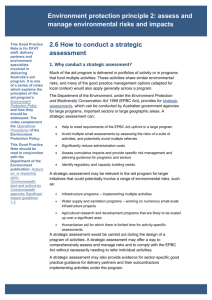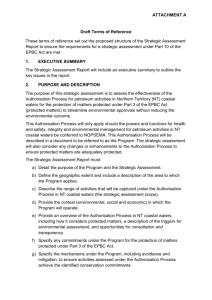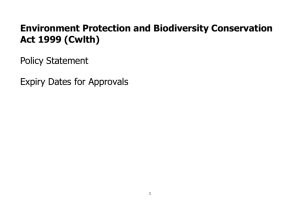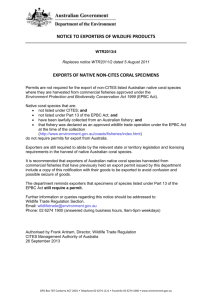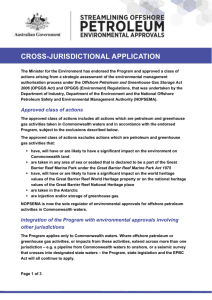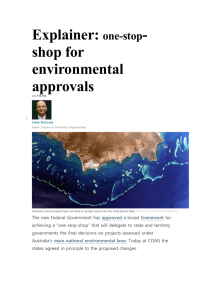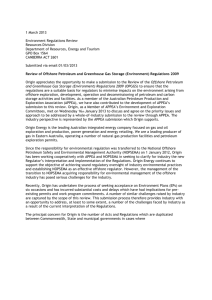strategic assessment means the strategic assessment to which this
advertisement
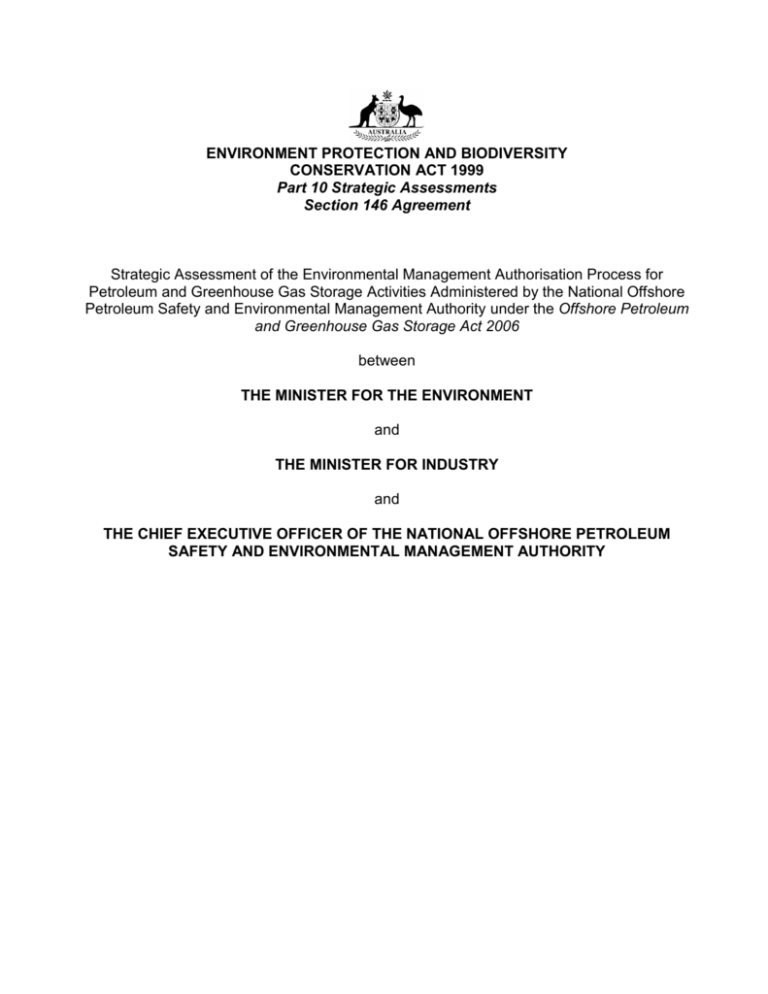
ENVIRONMENT PROTECTION AND BIODIVERSITY CONSERVATION ACT 1999 Part 10 Strategic Assessments Section 146 Agreement Strategic Assessment of the Environmental Management Authorisation Process for Petroleum and Greenhouse Gas Storage Activities Administered by the National Offshore Petroleum Safety and Environmental Management Authority under the Offshore Petroleum and Greenhouse Gas Storage Act 2006 between THE MINISTER FOR THE ENVIRONMENT and THE MINISTER FOR INDUSTRY and THE CHIEF EXECUTIVE OFFICER OF THE NATIONAL OFFSHORE PETROLEUM SAFETY AND ENVIRONMENTAL MANAGEMENT AUTHORITY CONTENTS 1 PARTIES ....................................................................................................................... 3 2 DEFINITIONS ............................................................................................................... 3 3 PREAMBLE................................................................................................................... 4 4 BACKGROUND ............................................................................................................ 5 5 TERMS OF REFERENCE FOR THE STRATEGIC ASSESSMENT REPORT .............. 6 6 PREPARATION OF THE STRATEGIC ASSESSMENT REPORT AND PROGRAM ..... 6 7 ENDORSEMENT OF THE PROGRAM ......................................................................... 7 8 APPROVAL OF ACTIONS UNDER THE PROGRAM ................................................... 8 9 VARIATION, CONFLICT RESOLUTION AND TERMINATION ...................................... 8 SIGNATURES................................................................................................................... 10 Attachment A – Final Terms of Reference ......................................................................... 11 Page 2 of 15 1 PARTIES The Parties to this agreement are: The Minister for the Environment and The Minister for Industry and The Chief Executive Officer of the National Offshore Petroleum Safety and Environmental Management Authority 2 DEFINITIONS 2.1 Unless stated otherwise in this Agreement, the definitions, meanings and terms in the Environment Protection and Biodiversity Conservation Act 1999 apply to this Agreement and its attachments. 2.2 In this Agreement: agreement means this strategic assessment agreement entered into between the parties on the date the last party executes this agreement. Commonwealth waters refers to the waters beyond the designated state and territory coastal waters, from the three nautical mile baseline to 200 nautical miles of Australia’s Exclusive Economic Zone. day means a business day in the Australian Capital Territory. Department means the Australian Government department administering the Environment Protection and Biodiversity Conservation Act 1999 (Cth). EPBC Act means the Environment Protection and Biodiversity Conservation Act 1999 (Cth). Minister means the Minister responsible for administering the EPBC Act or the Minister's authorised delegate. NOPSEMA National Offshore Petroleum Safety and Environmental Management Authority OPGGS Act means the Offshore Petroleum and Greenhouse Gas Storage Act 2006. OPGGS environmental management authorisation process means the assessment and acceptance process for environment plans by NOPSEMA under the Offshore Petroleum and Greenhouse Gas Storage Act 2006 and the Offshore Petroleum and Greenhouse Gas Storage (Environment Regulations) 2009. OPGGS Environment Regulations means the Offshore Petroleum and Greenhouse Gas Storage (Environment) Regulations 2009 Page 3 of 15 Parties mean the Minister for the Environment, the Minister for Industry, and the Chief Executive Officer of the National Offshore Petroleum Safety and Environmental Management Authority; each a Party. Program describes a document (or documents) that outlines the OPGGS environmental management authorisation process for petroleum activities. These documents must also demonstrate how NOPSEMA’s environmental management authorisation process will ensure that impacts on matters protected under Part 3 of the EPBC Act are not unacceptable. This constitutes the ‘policy, plan or program’ pursuant to section 146 of the EPBC Act. strategic assessment means the strategic assessment to which this agreement relates, namely an assessment of the adequacy of the Program to identify and manage impacts on matters protected under Part 3 of the EPBC Act. Strategic Assessment Report means the report prepared by NOPSEMA and the Department of Industry assessing how the implementation of the Program will ensure the appropriate level of consideration and management of impacts on matters protected under Part 3 of the EPBC Act. The Strategic Assessment Report will describe any commitments or undertakings required in the Program to ensure acceptable protection of matters protected under Part 3 of the EPBC Act, including through legislative, regulatory, policy and/or operational changes. Supplementary Report means the report prepared by NOPSEMA and the Department of Industry submitted to the Department following public exhibition of the draft Strategic Assessment Report and Program which addresses and responds to public comments including revisions to the Strategic Assessment Report and Program. Terms of Reference means the terms of reference for the Program and the Strategic Assessment Report. Work Plan means a plan jointly developed by the Parties for undertaking the strategic assessment, documenting a common understanding about what strategic assessment tasks will be completed by whom, by when, and what resources are required for those tasks, amongst other things. 3 PREAMBLE 3.1 Petroleum activities that are likely to have a significant impact on matters protected under Part 3 of the EPBC Act require assessment and approval under the EPBC Act. All offshore petroleum activities in Commonwealth waters also require assessment and authorisation under the OPGGS Act and the OPGGS Environment Regulations. 3.2 The parties agree to undertake a strategic assessment under the EPBC Act of the OPGGS environmental management authorisation process for petroleum activities administered by NOPSEMA. The strategic assessment will streamline the relationship between these regimes to maximise regulatory efficiency while retaining strong environmental safeguards. 3.3 The parties agree that significant economic, environmental and social benefit may be derived from developing and implementing a program that streamlines the relationship between these regimes with a view of maximising regulatory efficiency, while retaining Page 4 of 15 strong environmental safeguards for matters protected under Part 3 of the EPBC Act potentially affected by petroleum activities in Commonwealth Waters. 3.4 Recognising the benefits and potential impacts of petroleum activities, NOPSEMA will prepare a document (the Program) describing how the OPGGS environmental management authorisation process ensures protection of matters protected under Part 3 of the EPBC Act, and to undertake a strategic assessment of the Program. 3.5 The parties agree to share information in accordance with requirements in the OPGGS Act and the EPBC Act. 3.6 The parties agree to work cooperatively, including with key stakeholders, to avoid duplication and to progress the strategic assessment. 3.7 While the strategic assessment is underway it does not affect actions or activities already approved under the EPBC Act or prevent proponent’s seeking assessment and approval under Parts 7, 8 and 9 (referral, assessment and approval) of the EPBC Act. The requirements of the OPGGS Act and the OPGGS Environment Regulations also continue to apply. 4 BACKGROUND 4.1 Subsection 146(1) of the EPBC Act allows the Minister to agree in writing with a person responsible for the implementation of a policy, plan or program to assess the impacts of actions taken under that policy, plan or program on matters protected under Part 3 of the EPBC Act. 4.2 For the purposes of the Agreement, the policy, plan or program is a document describing the OPGGS environmental management authorisation process. A Strategic Assessment Report will be prepared to assess how the implementation of the policy, plan or program will ensure the appropriate level of consideration and management of impacts on matters protected under Part 3 of the EPBC Act. 4.3 A draft Strategic Assessment Report and draft Program will be made available for public comment for a minimum of 28 days. Following the public comment period, a Supplementary Report (addressing public comments) and a revised Program (if necessary) will be submitted to the Minister. 4.4 After considering these, the Minister may decide to endorse the Program if satisfied that the reports adequately address the impacts and endorsement criteria to which this Agreement relates and that recommended modifications (if any) to the Program made by the Minister, or modifications having the same effect, have been made. 4.5 The Parties acknowledge that the endorsement of the Program itself does not constitute any approval for the taking of actions under Part 10 of the EPBC Act. 4.6 If the Minister endorses the Program, the Minister may then approve the taking of an action, or class of actions, in accordance with the Program and the EPBC Act. The effect Page 5 of 15 of an approval decision is that any actions or class of actions approved under section 146B would not need further approval by the Minister under the EPBC Act if taken in accordance with the endorsed Program. 4.7 If the Minister endorses the Program, the Parties acknowledge that, where proponents propose to take an action in accordance with the Program that is not the subject of an approval under section 146B, they are able to seek approval for that action through the assessment and approval process established under Parts 7, 8 and 9 of the EPBC Act. Paragraphs 87(3)(b) and 136(2)(e) of the EPBC Act provide that the strategic assessment report for a policy, plan or program must be taken into account in deciding the level of assessment and approval for actions that are referred under the EPBC Act. 5 TERMS OF REFERENCE FOR THE STRATEGIC ASSESSMENT REPORT 5.1 In accordance with the provisions of paragraph 146(1B) (a) of the EPBC Act, the Parties shall as soon as practicable agree on the Terms of Reference to be used in this strategic assessment (at Attachment A). 6 PREPARATION OF THE PROGRAM AND STRATEGIC ASSESSMENT REPORT 6.1 NOPSEMA and the Department of Industry will prepare a Program and draft Strategic Assessment Report in accordance with this Agreement and the Final Terms of Reference (Attachment A). 6.2 The schedule of dates will be developed by officials from the Departments of the Environment and Industry and NOPSEMA. 6.3 NOPSEMA and the Department of Industry will release the Program and draft Strategic Assessment Report for public comment by notice, consistent with arrangements for other major environmental impact assessment projects, including: (a) posting on the relevant agency websites; (b) publishing notices in newspaper(s) with national circulation; and (c) circulation to key stakeholder groups agreed between the parties. 6.4 The notice inviting public comment must: (a) state the Program and draft Strategic Assessment Report are available for public comment; (b) advise how copies may be obtained; (c) provide contact details for obtaining further information; and (d) invite public comments on the draft reports for a period of at least 28 days, that is specified by the Minister. Page 6 of 15 6.5 Following the public comment period, NOPSEMA and the Department of Industry will: (a) prepare a Supplementary Report and revise the Program (if necessary), taking into account any public comments pursuant to clause 6.4(d); and (b) provide drafts of these reports to the Department for comment. 6.6 The Department agrees to assist NOPSEMA and the Department of Industry in ensuring that the reports adequately address the requirements for strategic assessments described in Part 10 of the EPBC Act and to provide comments in a timely manner. 7 ENDORSEMENT OF THE PROGRAM 7.1 NOPSEMA and the Department of Industry will submit to the Minister: (a) the draft Strategic Assessment Report (which was exhibited for public comment); (b) the Supplementary Report (explaining how relevant public responses have been taken into account); (c) the final Program (incorporating any revisions in light of public comments); (d) a summary of public comments received during the consultation relating to the Strategic Assessment Report and Program; and (e) any other documents required to support NOPSEMA and the Department of Industry’s submission. 7.2 In determining whether to endorse the Program, the Minister will have regard to the extent to which the Program meets the relevant objectives of the EPBC Act, specifically: (a) to provide for the protection of the environment, especially those aspects of the environment that are matters of national environmental significance; (b) to promote ecologically sustainable development through the conservation and ecologically sustainable use of natural resources; (c) to promote the conservation of biodiversity; (d) to provide for the protection and conservation of heritage; (e) to promote a co-operative approach to the protection and management of the environment involving governments, the community, land-holders and indigenous peoples; and (f) to assist in the co-operative implementation of Australia’s international environmental responsibilities. 7.3 If the Minister is not satisfied that the reports adequately address the impacts1 of actions on matters protected under Part 3 of the EPBC Act, or that the Program does not provide for adequate protection of matters protected under Part 3 of the EPBC Act, then: (a) the Minister can make recommendations to amend the Program; (b) NOPSEMA and the Department of Industry may seek clarification from the Minister on these recommendations; (c) NOPSEMA and the Department of Industry will then submit to the Minister for consideration the revised Program, and a summary of how the Minister’s recommendations were given effect; 1 Note: The reports submitted under clause 7.1 will demonstrate and assess the manner in which the OPGGS environmental management authorisation process requires these impacts to be addressed by petroleum activity duty holders. Page 7 of 15 (d) the Minister will consider the revised Program, and any supporting material provided, and may accept it as the final Program; and (e) the Minister may request further modifications if still not satisfied that the Program provides for adequate protection of matters protected under Part 3 of the EPBC Act. 7.4 The Minister may endorse the Program if satisfied that the reports submitted under clause 7.1 adequately address the impacts to which this Agreement relates, and that any recommended modifications to the Program (clause 7.3), or modifications having the same effect, have been addressed.2 7.5 If the Minister is satisfied, the Minister will approve the taking of a class of actions in accordance with the endorsed program in accordance with the considerations in Part 10, Subdivision C of the EPBC Act. 7.6 The Minister will make a decision on endorsement or otherwise within 28 days of receipt of the final Program. 8 APPROVAL OF ACTIONS UNDER THE PROGRAM 8.1 The EPBC Act provides that the Minister may approve, or approve with conditions, the taking of an action or class of actions in accordance with the endorsed Program under Section 146B of the EPBC Act. In doing so, the Minister must act in accordance with sections 146F-M of the EPBC Act. This includes considering matters protected under Part 3 of the EPBC Act affected by the Program and economic and social matters. 8.2 The Minister will seek comment from other Australian Government Ministers with administrative responsibilities relating to the proposed actions before approving the taking of an action, or class of actions, pursuant to section 146C of the EPBC Act. The comment period for each relevant Minister will be 10 days. 8.3 All Parties will make publicly available electronic copies of the endorsed Program, the draft Strategic Assessment Report, the Supplementary Report and any approval decision and conditions through their respective websites. 8.4 Additional approvals for actions or classes of actions may occur progressively after endorsement of the Program. 9 OPERATION OF AGREEMENT 9.1 The parties acknowledge and agree that though this Agreement is not binding as a matter of law, they will adhere to its terms and at all times conduct themselves as though they were bound. 2 Note: The reports submitted under clause 7.1 will demonstrate and assess the manner in which the OPGGS environmental management authorisation process requires these impacts to be addressed by petroleum activity duty holders. Page 8 of 15 10 VARIATION, CONFLICT RESOLUTION AND TERMINATION 10.1 This Agreement may only be varied by written agreement (including electronic communications) between the Parties and in accordance with the EPBC Act. 10.2 Where there is a dispute between the Parties to this Agreement on a particular matter, the Parties will consult in a spirit of mutual cooperation in relation to that matter and will use their best endeavours to negotiate a mutually acceptable resolution. 10.3 This Agreement may be terminated by any Party by written notice to the other parties. Page 9 of 15 SIGNATURES The Hon Greg Hunt MP Minister for the Environment Dated The Hon Ian Macfarlane MP Minister for Industry Dated Jane Cutler Chief Executive Officer NOPSEMA Dated Page 10 of 15 Attachment A – Final Terms of Reference These terms of reference set out the proposed structure of the Strategic Assessment Report to ensure the requirements for a strategic assessment under Part 10 of the EPBC Act are met. 1 EXECUTIVE SUMMARY The Strategic Assessment Report will include an executive summary to outline the key issues in the report. 2 PURPOSE AND DESCRIPTION The purpose of this strategic assessment is to assess the effectiveness of the offshore petroleum and greenhouse gas storage (OPGGS) environmental management authorisation process for the protection of matters protected under Part 3 of the EPBC Act (protected matters) to streamline environmental approvals without reducing the environmental outcome. The OPGGS environmental management authorisation process includes the Offshore Petroleum and Greenhouse Gas Storage Act 2006 (OPGGS Act) and associated Offshore Petroleum and Greenhouse Gas Storage (Environment) Regulations 2009 (Environment Regulations) for the assessment of petroleum activities and greenhouse gas storage activities (as defined in the Environment Regulations). This authorisation process will be described in a document to be referred to as the Program. The strategic assessment will also consider any changes or enhancements to the OPGGS environmental management authorisation process to ensure protected matters are adequately protected. The Strategic Assessment Report must include an overview of the Program and the strategic assessment process, including: a) the purpose of the Program and the Strategic Assessment. b) a description of the range of activities captured under the OPGGS environmental management authorisation process (the strategic assessment scope). c) an overview of the objectives of the EPBC Act and the OPGGS environmental management authorisation process, including a description of the triggers for environmental assessment, obligations under the EPBC Act, opportunities for public involvement, and transparency. d) an overview of the OPGGS environmental management authorisation process, including how it considers protected matters. e) any other relevant government or industry planning or management frameworks that are relevant to the OPGGS environmental management authorisation process and provide for the protection of protected matters. Page 11 of 15 f) An overview of how the strategic assessment will maximise regulatory efficiency, while retaining strong environmental safeguards. 3 MATTERS PROTECTED UNDER PART 3 OF THE EPBC ACT 3.1 Identification of Protected Matters The Strategic Assessment Report must address how the OPGGS environmental management authorisation process meets the objects of the EPBC Act and protects the following protected matters: World Heritage properties(sections 12 and 15A) National Heritage places (sections 15B and 15C) Ramsar wetlands (sections 16 and 17B) Listed threatened species and communities (sections 18 and 18A) Listed migratory species (sections 20 and 20A) Commonwealth marine areas (sections 23 and 24A) The environment on Commonwealth land (sections 26 and 27A). 3.2 Identification and analysis of the OPGGS environment management authorisation process The Strategic Assessment Report must include: a) comparison of the OPGGS environmental management authorisation process and regulatory requirements of the EPBC Act for protection of protected matters, including the referral, assessment and approvals regime under Chapter 4, and compliance and regulatory regimes. This includes showing, for example through process mapping: how the OPGGS environmental management authorisation process identifies and assesses potential impacts on protected matters, including how the OPGGS environmental management authorisation process requires proponents to: i. describe the nature of proposed petroleum and greenhouse gas activities and the baseline environment. ii. provide a description of type and likelihood of risks considered and conduct a risk assessment to evaluate the potential risks and prepare appropriate response strategies that adequately address protected matters. iii. implement an approach that firstly seeks to avoid impacts on protected matters, and then seeks to mitigate residual impacts. Page 12 of 15 iv. apply relevant policies, industry practices and administrative guidelines for the protection of protected matters, including existing policy statements, Recovery Plans, Conservation Advices, Threat Abatement Plans, Marine Bioregional Plans, Commonwealth Marine Reserve Management Plans, and other relevant Australian Government Documents. v. undertake appropriate and timely public consultation commensurate to the activity. vi. address direct and indirect impacts of activities under NOPSEMA’s jurisdiction. vii. describe the baseline environment, and consider the other long term influences, including the potential impacts of climate change, that may also impact on protected matters in the receiving environment (for example, including information available from the public domain). how the impact assessment process under the EPBC Act, including relevant policies and guidelines, identifies and assesses potential impacts on protected matters. how the OPGGS environmental management authorisation process and the EPBC Act process incorporate transparency and public consultation processes during the assessment process and decision making. b) consideration of the OPGGS environmental management authorisation process against formal accreditation standards may be developed by the Department of the Environment, if appropriate. c) any specific changes or amendments to be made to regulations or regulatory policies to meet the requirements of the EPBC Act and ensure adequate protection of protected matters, and an assessment of the likely effectiveness and outcomes of these changes. The Strategic Assessment Report must include an analysis of the effectiveness of the OPGGS environmental management authorisation process in protecting protected matters and achieving good conservation outcomes. d) identification of other relevant authorities (including state and territory authorities) responsible for the implementation of key recommendations, if any. Page 13 of 15 4 PROMOTING ECOLOGICALLY SUSTAINABLE DEVELOPMENT The Strategic Assessment Report must identify how the principles of ecologically sustainable development (section 3A of the EPBC Act) are applied in the OPGGS environmental management authorisation process and how the process will ensure proponents will continue to implement/improve these principles. 5 ADAPTIVE MANAGEMENT: ADDRESSING UNCERTAINTY AND MANAGING RISK The Strategic Assessment Report must identify how the OPGGS environmental management authorisation process requires proponents to demonstrate: a) the degree to which adaptive management strategies would be implemented for activities permissioned under the OPGGS environmental management authorisation process to ensure protected matters are effectively protected to address uncertainties and inherent risks where they arise in proposed petroleum activities and greenhouse gas storage activities. Uncertainties could, for example, include knowledge gaps in scientific understanding and changing thresholds of acceptability for noise and other impacts. b) how monitoring of protected matters will be addressed through approved implementation strategies to achieve the desired conservation outcomes. c) how the monitoring will be analysed throughout the life of the OPGGS environmental management authorisation process and how the results of the monitoring will inform adaptive management in the OPGGS environmental management authorisation process. d) how new information relating to protected matters, including new listings under the EPBC Act, will be addressed through the OPGGS environmental management authorisation process. The Strategic Assessment Report must also detail NOPSEMA’s compliance monitoring processes for these outcomes. 6 AUDITING AND REPORTING The Strategic Assessment Report must set out how: a) the OPGGS environmental management authorisation process requires NOPSEMA to undertake monitoring and auditing, including any third party auditing of proponents, and public reporting of results. b) NOPSEMA uses monitoring and auditing results to ensure ongoing improvement within the OPGGS environmental management authorisation process. c) NOPSEMA reports on its regulatory responsibilities and demonstrates accountability. Page 14 of 15 7 REVIEW OR MODIFICATION OF PROGRAM The Strategic Assessment Report must identify and analyse the likely circumstances and procedures that may result in the review or modification of the Program if it is endorsed, and how endorsement would be maintained. 8 REFERENCES AND INFORMATION SOURCES The Strategic Assessment Report will include a list of references. For information and data used in the assessment, the Strategic Assessment Report must state: a) the source and currency (date) of the information b) the reliability and limitations of the information. Page 15 of 15
